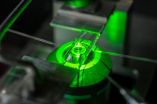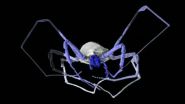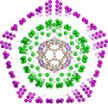(Press-News.org) Scientists may have discovered how the most common genetic cause of Parkinson's disease destroys brain cells and devastates many patients worldwide. The study was partially funded by the National Institutes of Health's National Institute of Neurological Disorders and Stroke (NINDS); the results may help scientists develop new therapies.
"This may be a major discovery for Parkinson's disease patients," said Ted Dawson, M.D., Ph.D., director of the Johns Hopkins University (JHU) Morris K. Udall Center of Excellence for Parkinson's Disease, Baltimore, MD. Dr. Dawson and his wife Valina Dawson, Ph.D., director of the JHU Stem Cell and Neurodegeneration Programs at the Institute for Cell Engineering, led the study published in Cell.
The investigators found that mutations in a gene called leucine-rich repeat kinase 2 (LRRK2; pronounced "lark two" or "lurk two") may increase the rate at which LRRK2 tags ribosomal proteins, which are key components of protein-making machinery inside cells. This could cause the machinery to manufacture too many proteins, leading to cell death.
"For nearly a decade, scientists have been trying to figure out how mutations in LRRK2 cause Parkinson's disease," said Margaret Sutherland, Ph.D., a program director at NINDS. "This study represents a clear link between LRRK2 and a pathogenic mechanism linked to Parkinson's disease."
Affecting more than half a million people in the United States, Parkinson's disease is a degenerative disorder that attacks nerve cells in many parts of the nervous system, most notably in a brain region called the substantia nigra, which releases dopamine, a chemical messenger important for movement. Initially, Parkinson's disease causes uncontrolled movements; including trembling of the hands, arms, or legs. As the disease gradually worsens, patients lose ability to walk, talk or complete simple tasks.
For the majority of cases of Parkinson's disease, a cause remains unknown. Mutations in the LRRK2 gene are a leading genetic cause. They have been implicated in as many as 10 percent of inherited forms of the disease and in about 4 percent of patients who have no family history. One study showed that the most common LRRK2 mutation, called G2019S, may be the cause of 30-40 percent of all Parkinson's cases in people of North African Arabic descent.
LRRK2 is a kinase enzyme, a type of protein found in cells that tags molecules with chemicals called phosphate groups. The process of phosphorylation helps regulate basic nerve cell function and health. Previous studies suggest that disease-causing mutations, like the G2019S mutation, increase the rate at which LRRK2 tags molecules. Identifying the molecules that LRRK2 tags provides clues as to how nerve cells may die during Parkinson's disease.
In this study, the researchers used LRRK2 as bait to fish out the proteins that it normally tags. Multiple experiments performed on human kidney cells suggested that LRRK2 tags ribosomal proteins. These proteins combine with other molecules, called ribonucleic acids, to form ribosomes, which are the cell's protein-making factories.
Further experiments suggested that disease-causing mutations in LRRK2 increase the rate at which it tags two ribosomal proteins, called s11 and s15. Moreover, brain tissue samples from patients with LRRK2 mutations had greater levels of phosphorylated s15 than seen in controls.
Next, the researchers investigated whether phosphorylation could be linked to cell death, by studying nerve cells derived from rats or from human embryonic stem cells. Genetically engineering the cells to have a LRRK2 mutant gene increased the amount of cell death and phosphorylated s15. In contrast, the researchers prevented cell death when they engineered the cells to also make a mutant s15 protein that could not be tagged by LRRK2.
"These results suggest that s15 ribosome protein may play a critical role in the development of Parkinson's disease," said Dr. Dawson.
How might phosphorylation of s15 kill nerve cells? To investigate this, Dr. Dawson and his colleagues performed experiments on fruit flies.
Previous studies on flies showed that genetically engineering dopamine-releasing nerve cells to overproduce the LRRK2 mutant protein induced nerve cell damage and movement disorders. Dr. Dawson's team found that the brains of these flies had increased levels of phosphorylated s15 and that engineering the flies so that s15 could not be tagged by LRRK2 prevented cell damage and restored normal movement.
Interestingly, the brains of the LRRK2 mutant flies also had abnormally high levels of all proteins, suggesting that increased s15 tagging caused ribosomes to make too much protein. Treating the flies with low doses of anisomycin, a drug that blocks protein production, prevented nerve cell damage and restored the flies' movement even though levels of s15 phosphorylation remained high.
"Our results support the idea that changes in the way cells make proteins might be a common cause of Parkinson's disease and possibly other neurodegenerative disorders," said Dr. Dawson.
Dr. Dawson and his colleagues think that blocking the phosphorylation of s15 ribosomal proteins could lead to future therapies as might other strategies which decrease bulk protein synthesis or increase the cells' ability to cope with increased protein metabolism. They also think that a means to measure s15 phosphorylation could also act as a biomarker of LRRK2 activity in treatment trials of LRRK2 inhibitors.
INFORMATION:
This work was supported by grants from the NINDS (NS038377, NS072187), the JPB Foundation, the Maryland Stem Cell Research Fund (2007-MSCRFI-0420-00, 2009-MSCRFII-0125-00, 2013-MSCRFII-0105-00), and the New York Stem Cell Foundation.
References:
Martin et al. "Ribosomal protein s15 phosphorylation mediates LRRK2 neurodegeneration in Parkinson's disease," Cell, April 10, 2014. DOI: 10.1016/j.cell.2014.01.064
For more information about Parkinson's disease, please visit:
http://www.ninds.nih.gov/disorders/parkinsons_disease/parkinsons_disease.htm
NINDS is the nation's leading funder of research on the brain and nervous system. The mission of NINDS is to seek fundamental knowledge about the brain and nervous system and to use that knowledge to reduce the burden of neurological disease.
About the National Institutes of Health (NIH): NIH, the nation's medical research agency, includes 27 Institutes and Centers and is a component of the U.S. Department of Health and Human Services. NIH is the primary federal agency conducting and supporting basic, clinical, and translational medical research, and is investigating the causes, treatments, and cures for both common and rare diseases. For more information about NIH and its programs, visit http://www.nih.gov.
Too much protein may kill brain cells as Parkinson's progresses
NIH-funded study on key Parkinson's gene finds a possible new target for monitoring the disease
2014-04-10
ELSE PRESS RELEASES FROM THIS DATE:
Researchers determine how mechanical forces affect T-cell recognition and signaling
2014-04-10
T-cells are the body's sentinels, patrolling every corner of the body in search of foreign threats such as bacteria and viruses. Receptor molecules on the T-cells identify invaders by recognizing their specific antigens, helping the T-cells discriminate attackers from the body's own cells. When they recognize a threat, the T-cells signal other parts of the immune system to confront the invader.
These T-cells use a complex process to recognize the foreign pathogens and diseased cells. In a paper published this week in the journal Cell, researchers add a new level of understanding ...
Researchers identify transcription factors distinguishing glioblastoma stem cells
2014-04-10
The activity of four transcription factors – proteins that regulate the expression of other genes – appears to distinguish the small proportion of glioblastoma cells responsible for the aggressiveness and treatment resistance of the deadly brain tumor. The findings by a team of Massachusetts General Hospital (MGH) investigators, which will be published in the April 24 issue of Cell and are receiving advance online release, support the importance of epigenetics – processes controlling whether or not genes are expressed – in cancer pathology and identify molecular circuits ...
Yale researchers search for earliest roots of psychiatric disorders
2014-04-10
Newborns whose mothers were exposed during pregnancy to any one of a variety of environmental stressors — such as trauma, illness, and alcohol or drug abuse — become susceptible to various psychiatric disorders that frequently arise later in life. However, it has been unclear how these stressors affect the cells of the developing brain prenatally and give rise to conditions such as schizophrenia, post-traumatic stress disorder, and some forms of autism and bipolar disorders.
Now, Yale University researchers have identified a single molecular mechanism in the developing ...
Some birds come first -- a new approach to species conservation
2014-04-10
New Haven, Conn.— A Yale-led research team has developed a new approach to species conservation that prioritizes genetic and geographic rarity and applied it to all 9,993 known bird species.
"To date, conservation has emphasized the number of species, treating all species as equal," said Walter Jetz, the Yale evolutionary biologist who is lead author of a paper published April 10 in Current Biology. "But not all species are equal in their genetic or geographic rarity. We provide a framework for how such species information could be used for prioritizing conservation."
Worldwide, ...
Penn study finds mechanism that regulates lung function in disease Birt-Hogg-Dube syndrome
2014-04-10
(PHILADELPHIA) – Researchers at Penn Medicine have discovered that the tumor suppressor gene folliculin (FLCN) is essential to normal lung function in patients with the rare disease Birt-Hogg-Dube (BHD) syndrome, a genetic disorder that affects the lungs, skin and kidneys. Folliculin's absence or mutated state has a cascading effect that leads to deteriorated lung integrity and an impairment of lung function, as reported in their findings in the current issue of Cell Reports.
"We discovered that without normal FLCN the alveolar epithelial cells (AEC) in these patients' ...
Ancient 'spider' images reveal eye-opening secrets
2014-04-10
VIDEO:
This is a video showing the 305-million-year-old harvestman fossil.
Click here for more information.
Stunning images of a 305-million-year-old harvestman fossil reveal ancestors of the modern-day arachnids had two sets of eyes rather than one.
The researchers say their findings, published in the journal Current Biology, add significant detail to the evolutionary story of this diverse and highly successful group of arthropods, which are found on every continent except Antarctica.
University ...
Poor mimics can succeed as long as they mimic the right trait
2014-04-10
There are both perfect and imperfect mimics in nature. An imperfect mimic might have a different body shape, size or colour pattern arrangement compared to the species it mimics.
Researchers have long been puzzled by the way poor mimicry can still be effective in fooling predators not to attack. In the journal Current Biology, researchers from Stockholm University now present a novel solution to the question of imperfect mimicry.
Mimicry is when animals have the appearance of another species in order to avoid being attacked. For instance, hoverflies have a similar ...
Enzyme 'wrench' could be key to stronger, more effective antibiotics
2014-04-10
Builders and factory workers know that getting a job done right requires precision and specialized tools. The same is true when you're building antibiotic compounds at the molecular level. New findings from North Carolina State University may turn an enzyme that acts as a specialized "wrench" in antibiotic assembly into a set of wrenches that will allow for greater customization. By modifying this enzyme, scientists hope to be able to design and synthesize stronger, more adaptable antibiotics from less expensive, natural compounds.
Kirromycin is a commonly known antibiotic ...
NEJM: High-risk seniors surgery decisions should be patient-centered, & physician led
2014-04-10
Surgery for frail, senior citizen patients can be risky. A new patient-centered, team-based approach to deciding whether these high-risk patients will benefit from surgery is championed in an April 10 Perspective of the New England Journal of Medicine. The Perspective suggests that the decision to have surgery must balance the advantages and disadvantages of surgical and non-surgical treatment as well as the patient's values and goals in a team-based setting that includes the patient, his or her family, the surgeon, the primary care physician and the physician anesthesiologist.
One ...
Virus structure inspires novel understanding of onion-like carbon nanoparticles
2014-04-10
Symmetry is ubiquitous in the natural world. It occurs in gemstones and snowflakes and even in biology, an area typically associated with complexity and diversity. There are striking examples: the shapes of virus particles, such as those causing the common cold, are highly symmetrical and look like tiny footballs.
A research programme led by Reidun Twarock at the University of York, UK has developed new mathematical tools to better understand the implications of this high degree of symmetry in these systems. The group pioneered a mathematical theory that reveals unprecedented ...
LAST 30 PRESS RELEASES:
Fathers’ microplastic exposure tied to their children’s metabolic problems
Research validates laboratory model for studying high-grade serous ovarian cancer
SIR 2026 delivers transformative breakthroughs in minimally invasive medicine to improve patient care
Stem Cell Reports most downloaded papers of 2025 highlight the breadth and impact of stem cell research
Oxford-led study estimates NHS spends around 3% of its primary and secondary care budget on the health impacts of heat and cold in England
A researcher’s long quest leads to a smart composite breakthrough
Urban wild bees act as “microbial sensors” of city health.
New study finds where you live affects recovery after a hip fracture
Forecasting the impact of fully automated vehicle adoption on US road traffic injuries
Alcohol-related hospitalizations from 2016 to 2022
Semaglutide and hospitalizations in patients with obesity and established cardiovascular disease
Researchers ‘listen in’ to embryo-mother interactions during implantation using a culture system replicating the womb lining
How changing your diet could help save the world
How to make AI truly scalable and reliable for real-time traffic assignment?
Beyond fragmented markets: A new framework for efficient and stable ride-pooling
Can shape priors make road perception more reliable for autonomous driving?
AI tracks nearly 100 years of aging research, revealing key trends and gaps
Innovative techniques enable Italy’s first imaging of individual trapped atoms
KIER successfully develops Korea-made “calibration thermoelectric module” for measuring thermoelectric device performance
Diversifying US Midwest farming for stability and resilience
Emphasizing immigrants’ deservingness shifts attitudes
Japanese eels, climate change, and river temperature
Pusan National University researchers discover faster, smarter heat treatment for lightweight magnesium metals
China’s 2024 Gastroenterology Report: marked progress in endoscopy quality and disease management
Pusan National University researchers uncover scalable method for ultrahigh-resolution quantum dot displays
Researchers use robotics to find potential new antibiotic among hundreds of metal complexes
Gut bacteria changes at the earliest stages of inflammatory bowel disease
Scientists develop new way to “listen in” on the brain’s hidden language
Brain research: “Pulse generators” grow and shrink as memories are formed
For teens, any cannabis use may have impact on emotional health, academic performance
[Press-News.org] Too much protein may kill brain cells as Parkinson's progressesNIH-funded study on key Parkinson's gene finds a possible new target for monitoring the disease



